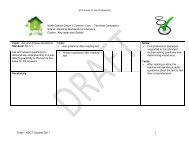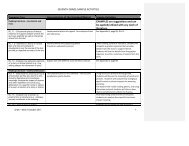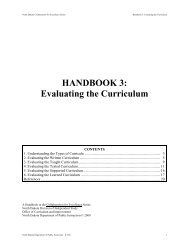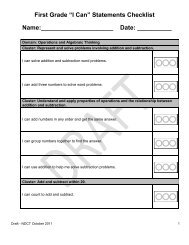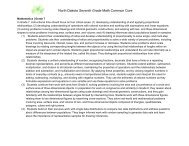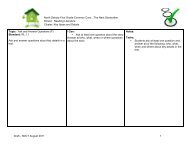A. ND Mathematics Content Standards, Grade 5 - ND Curriculum ...
A. ND Mathematics Content Standards, Grade 5 - ND Curriculum ...
A. ND Mathematics Content Standards, Grade 5 - ND Curriculum ...
You also want an ePaper? Increase the reach of your titles
YUMPU automatically turns print PDFs into web optimized ePapers that Google loves.
Table 3. The properties of operations. Here a, b and c stand for arbitrary numbers in a given number system. The<br />
properties of operations apply to the rational number system, the real number system, and the complex number<br />
system.<br />
Associative property of addition (a + b) + c = a + (b + c)<br />
Commutative property of addition<br />
a + b = b + a<br />
Additive identity property of 0<br />
a + 0 = 0 + a = a<br />
Ex istence of additive inverses For every a there exists –a so that a + (–a) = (–a) + a = 0.<br />
Associative property of multiplication (a × b) × c = a × (b × c)<br />
Commutative property of multiplication<br />
a × b = b × a<br />
Multiplicative identity property of 1<br />
a × 1 = 1 × a = a<br />
Ex istence of multiplicative inverses For every a ≠ 0 there exists 1/a so that a × 1/a = 1/a × a = 1.<br />
Distributive property of multiplication over addition<br />
a × (b + c) = a × b + a × c<br />
Table 4. The properties of equality. Here a, b and c stand for arbitrary numbers in the rational, real, or complex<br />
number systems.<br />
Reflexive property of equality<br />
a = a<br />
Sy mmetric property of equality If a = b, then b = a.<br />
Transitive property of equality If a = b and b = c, then a = c.<br />
Addition property of equality If a = b, then a + c = b + c.<br />
Subtraction property of equality If a = b, then a – c = b – c.<br />
Multiplication property of equality If a = b, then a × c = b × c.<br />
Division property of equality If a = b and c ≠ 0, then a ÷ c = b ÷ c.<br />
Substitution property of equality If a = b, then b may be substituted for a in any expression containing a.<br />
Table 5. The properties of inequality. Here a, b and c stand for arbitrary numbers in the rational or real number<br />
systems.<br />
Exactly one of the follow ing is true: a < b, a = b, a > b.<br />
If a > b and b > c then a > c.<br />
If a > b, then b < a.<br />
If a > b, then –a < –b.<br />
If a > b, then a ± c > b ± c.<br />
If a > b and c > 0, then a × c > b × c.<br />
If a > b and c < 0, then a × c < b × c.<br />
If a > b and c > 0, then a ÷ c > b ÷ c.<br />
If a > b and c < 0, then a ÷ c < b ÷ c.<br />
Table 6. Polynomial Identities include but are not limited to:<br />
North Dakota <strong>Mathematics</strong> <strong>Content</strong> <strong>Standards</strong><br />
Based on the Common Core State <strong>Standards</strong><br />
Glossary 23 June 2011





